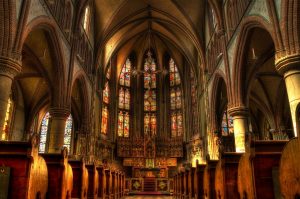
“Beauty calls us home. It awakens and transports us. Beauty – in nature, in art, in humans, in the divine – awakens a longing within us for a world where everything is as it should be, where everything fits together in the right way.” -Paul Gould, Cultural Apologetics
“For we are God’s handiwork, created in Christ Jesus to do good works, which God prepared in advance for us to do.” – Ephesians 2:10
Beauty, because it awakens the imagination to deep and holy longings, is a foundation stone of cultural apologetics. Thus, we call the church to affirm and support both the arts in general and those particular artists who are members of Christ’s church. In pursuit of the latter, we (1) identify the artist’s skill and vision as part of the very image of God within humanity (God himself is the artist who brought order and beauty from chaos in Genesis 1) and (2) celebrate the presence of artists within God’s people from the very beginning. How remarkable it is to discover that even in the midst of slavery in Egypt, Israel somehow maintained an artistic community (Exodus 31:1-11). Even more remarkable is the part of the story where God calls and empowers that community to construct the tabernacle. Not only were artists present within Israel from its inception, but they were also responsible for building the structure that would serve as both the seat of God’s presence and the center of Israel’s communal life. Art, which orders chaos and projects beauty, is a good and necessary piece of Christ’s church and the wider world.
Now, let us continue our examination of the tabernacle to discern another aspect of beauty and artistry within the church. As the story goes, God gave detailed instructions for the construction of the tabernacle and then called and empowered Israel’s artistic community to carry out his vision. From this vantage point, God acts as the master artist who employs artisans within his own shop. The finished product, ordered by God and accomplished by his workers, then stands as a work of beauty unto itself and the site of God’s presence in Israel. Linking these two realities, we might say that the tabernacle was a place of beauty because God chose to inhabit it. It was only fitting that God’s dwelling place be beautiful. This was true first of the tabernacle and then the temple.
Fast forward now to New Covenant times. God still has a chosen dwelling place on the earth, but it is no longer a matter of tents or buildings. Rather, the Spirit of God dwells in and among his people, the church. Thus, we find imagery in the New Testament that presents Jesus as the cornerstone, the apostles and prophets as foundation stones, and believers as the stones that make up the structure of God’s house (see Ephesians 2:19-22; 1 Peter 2:4-10). Through the work of Christ, God’s dwelling is no longer a tabernacle or temple. No, he dwells within a community.
This truth begs an important question: What kind of community is a fitting dwelling place for God’s presence? Descriptions like holy and righteous readily come to mind, and they should. We derive these words from scripture, and they remind us that the church is meant to reflect the holiness and righteousness of God. Might I add another descriptor, though? What if the hallmark of the church’s identity is beauty? God himself is beautiful, and his holiness and righteousness are aspects of his beauty. Just as the tabernacle and temple were beautiful structures for God’s dwelling, the church is called to be a beautiful community for the same.
Of course, the church will not fully live up to this high calling until Jesus returns. At the same time, we are called to actively pursue it in the here and now. And, in the same way that God set aside and empowered artisans to build the tabernacle, so also has he set aside artisans for the construction of his beautiful community. These are the apostles, prophets, pastor-teachers, and evangelists whom God has given to the church for its growth toward maturity (see Ephesians 4:11-13). The tools of their trade are teaching, worship, shared life, and more. Importantly, these church leaders do not build and create according to their own whims or aesthetics. No, as was the case with the tabernacle, God himself has laid out the pattern of his community in Christ, and church leaders act as artisans in his employ. He is the master artist, and they are the implementers of his vision.
When we think of beauty, we readily think of how the church can support the arts. We need to go a step further, though, to realize that the church itself is a work of art. The high calling of pastors and other church leaders is, by God’s pattern and with his help, to construct a beautiful community that is worthy of God’s dwelling. When we do, the beauty of the church becomes a primary apologetic to the surrounding culture. Imagine! What if the culture, though it might disagree with us, nevertheless was compelled to acknowledge the beauty of our life together? What if we, as God’s own art installation, stirred the disenchanted imaginations of a watching world?
–by Mike Smith
We welcome outside writers to contribute to “Ideas and the Kingdom.” We are looking for individuals who are passionate about showing the reasonableness and desirability of Christianity by restoring the Christian voice, conscience, and imagination. We are looking for posts that are 400-800 words in length and submissions can be made to TwoTasksInstitute@gmail.com.




